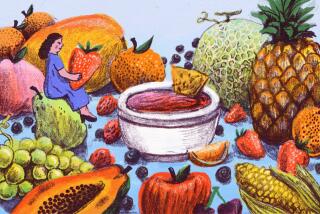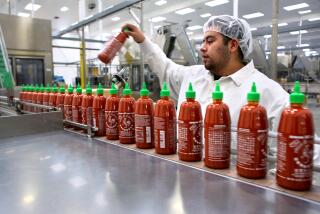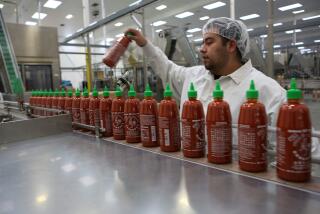Market Scene : Chileans Savor Sweet Advantage in Fruit Industry : The South American nation is the world’s leading exporter of winter fruit. More than 40% goes to the U.S.
- Share via
COLTAUCO, Chile — On a busy summer day in a sun-splashed orchard, workers hurry to harvest a bumper crop of plump and blushing nectarines, spilling them from baskets into a trailer parked between rows of trees.
A tractor will take the nectarines to a nearby packing plant, where they will cool off in a huge refrigeration chamber. In a few days, after sorting and packing, the fruit will be trucked to Valparaiso and loaded on refrigerated ships going to the United States and other countries.
“Right now we’re starting to send a lot of fruit to the United States, East Coast and West Coast,” said Ricardo Vial, export manager for a group of farms here. As he strolled through an orchard, Vial listed some of the fruit he will be sending to California in the coming weeks: “nectarines, peaches, plums, grapes--a lot of them--and pears.”
Chile is the world’s leading exporter of “winter fruit” (not counting citrus, bananas and other tropical fruit), harvested when trees are bare in most of the Northern Hemisphere. Chilean fruit exports have grown into almost a billion-dollar industry, helping to nourish this South American country’s remarkable economic development in the past decade.
Depressed prices for apples in Europe made 1993 a disappointing year for many Chilean fruit growers. But as this season’s harvest goes into high gear, they are expecting a happier 1994.
Thirty years ago, Coltauco agriculture was mostly annual crops such as corn and wheat, wine vineyards, and dairy herds and other livestock. Only a few farmers were beginning to grow fruit for export.
“My grandfather Miguel started with nectarines around 1965,” Vial said. “He exported to the United States.”
Now, like many rural areas of central Chile, the township of Coltauco, 70 miles south of Santiago, relies on fruit exports as a major source of livelihood. This is a patchwork quilt of orchards and vineyards, dotted with refrigeration and packing plants where workers process fruit with modern conveyor equipment, and where office personnel keep track of business with computers.
According to the Chilean Exporters Assn., the export of fruits and vegetables directly employs 4.4% of the Chilean labor force, or more than 200,000 workers. While many of the jobs are low-skill, the export industry has increased opportunities for better-paid equipment operators, technicians and clerical workers.
Chile accounts for about 45% of the Southern Hemisphere’s exports of apples, pears, peaches and table grapes, up from 4% in the early 1960s. From 1986 to 1991 alone, Chile’s fresh fruit exports increased by 69%, from 665,000 to 1.1 million metric tons. More than 40% goes to the United States.
In 1981, Chilean fruit exports brought in less than $200 million. This year’s revenues are expected to surpass the 1991 record of $991 million.
Last year’s revenues dropped to $862 million, mainly because of low apple prices in Europe. The problem started with a bumper crop of European apples, which can be stored into the winter season. Amid fears that the oversupply might prompt the European Community to impose a system of licensing apple imports, Chilean exporters rushed shipments to get their apples in before any quotas were set.
The glut brought prices down rapidly. The European Community--now called the European Union--levied heavy compensatory import taxes on imported apples. With the added taxes, Chilean producers could not cover their costs. Uncounted acres of apples were left unpicked, and big growers lost millions of dollars.
An additional problem that made things worse for Chile was its lack of quality control. With no industrywide grading system to separate high- and low-quality fruit, mediocre Chilean apples pulled down prices for the good ones.
Legislation has been proposed to impose an industrywide system of grading for export fruit, but passage appears uncertain. Meanwhile, many growers and exporters have agreed to start a voluntary system of quality certification.
“As long as it isn’t obligatory, it’s going to be hard to make quality control effective,” predicted Ramon Achurra, a Coltauco grower and exporter.
Many Chilean growers worry that Chile’s quality control problem eventually could seriously erode this country’s share of the winter fruit market as other Southern Hemisphere countries push to increase their shares.
In South America, Argentina is a major fruit exporter and Brazil has big potential for exporting winter fruits. South Africa and New Zealand are also important Southern Hemisphere producers.
Argentina already exports more pears than Chile and almost as many apples. But Chile’s overall fruit exports are more than double Argentina’s.
South Africa and New Zealand have been successful at developing new varieties of fruit that capture consumer perference. Smart Chilean growers have been able to follow suit, planting the new varieties as their popularity increases. For example, new red apple varieties that are spreading in Chile include the Royal Gala, the Braeburn and the Fuji.
Chileans also have ventured successfully into new species after spotting potential markets that they can supply. They planted some 27,000 acres of kiwi, winning a big share of the 1980s boom in that fruit, and more recently they have been investing heavily in berries for export.
A new entry in the Chilean export cornucopia is the cherimoya, a delicious custard fruit of Andean origin that recently has been approved for marketing in the United States.
Chile holds its biggest advantage in table grapes, nectarines and peaches, with more than 80% of the Southern Hemisphere’s total exports. Table grapes are Chile’s biggest export crop by far, and most go to the United States.
Of the 58.3 million boxes of Chilean fruit and vegetables sent to the United States during the season that ended last August, 16.3 million boxes went to the West Coast, and all but 300,000 of those were unloaded at the Port of Los Angeles.
The United States and Europe buy three-fourths of Chile’s fruit exports. Exporters are trying to diversify the market, with notable success. Last year, sales to Latin America doubled, accounting for 14% of total fruit exports.
“That has been a very pleasant surprise for us,” said Ronald Bown Fernandez, president of the Chilean Exporters Assn.
Growth in fruit exports to many countries has been slowed in recent years by international recession. But Bown predicted in an interview that economic recovery in the United States and other northern countries will stimulate the world’s appetite for fruit.
“It’s going to be an excellent business for Chile,” he said.
Central Chile’s Mediterranean climate, with rainy winters and sunny summers, give it natural advantages for fruit production. Low labor costs, relatively inexpensive land and a stable business climate favoring free enterprise and international trade have encouraged investment in fruit since the 1970s, Bown said.
Chile’s fruit-growing area has expanded to nearly 400,000 acres from 116,000 acres in 1965.
Bown said he is not worried that the Northern Hemisphere’s winter fruit market could become saturated by increased exports from Chile and other Southern Hemisphere countries. He cited a trend of increasing consumption of fruit and vegetables in developed countries.
The exporters association is contributing $30,000 this year to a U.S. publicity campaign encouraging consumers to eat at least five portions of fruits and vegetables a day for a healthy diet. The “five-a-day” campaign, started in California in 1988, is sponsored by the Produce for Better Health Foundation in cooperation with the National Cancer Institute.
Bown said emphasis on healthier eating is expected to double per-capita fruit consumption in the United States within 10 years. And he said the movement is likely to spread to Europe.
Chilean exporters are also interested in joining U.S. produce organizations in promotional projects aimed at increasing demand for different kinds of fruit. The Chilean Exporters Assn. recently signed a preliminary agreement with the California Kiwi Fruit Commission for a campaign to promote “kiwi fruit of the Americas.”
More to Read
Sign up for Essential California
The most important California stories and recommendations in your inbox every morning.
You may occasionally receive promotional content from the Los Angeles Times.










